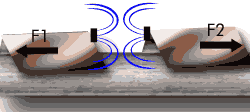(151 class -- please take a moment to clean your air track, as you are the first class of the day)
- Level your air track in the manner that we discussed in the Air Track experiment (do this very thoroughly!!)
- You will be assigned mass 1 and mass 2 for your group.
- Measure the mass of your two carts (do not trust previous student labels!)
- Place mass 2 in the middle of the air track at rest
- Set mass 1 at the end of the track, and give it an arbitrary velocity. (You may wish to practice these next few steps a few times without making a record).
- Start the spark timer for mass 1 once you are clear of the track.
- Stop the spark timer for mass 1 when it approaches mass 2, and start the spark timer for mass 2
- Stop the spark timer for mass 2 when it reaches the end of the track.
- Repeat steps 4-7 four more times.
- Calculate the TE ratio and SDM of the TE and write your value on the board.
- Plot the class TE on
Figure 1, page 65.
1) The masses should never actually touch. As we learned last time, that causes a great deal of lost energy. Instead the magnets should repel the carts.

|

|
|
bad collision
|
good collision
|
